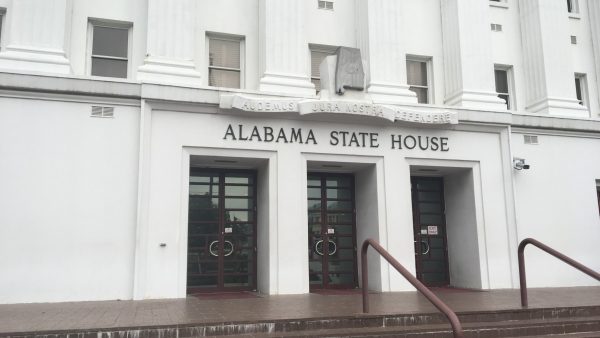Remembering a Martyr
Situated between Montgomery and Selma, Lowndes County has seen its share of civil rights marches.
But a recent march didn’t following the ‘Bloody Sunday’ route taken by the freedom riders in 1965. The marchers solemnly followed the much shorter path taken by Jonathon Myrick Daniels that same year.
Jon Daniels was an Episcopal Seminarian, originally from New Hampshire, who came to Alabama to fight for black voting rights, in a county with a population overwhelmingly black.
The atmosphere for blacks and outsiders in Lowndes County was none too friendly in the 1960s. Black civil rights activists, such as the Rev. Fred Shuttlesworth and Stokely Carmichael, and white outsiders including Jonathon Daniels and Father Francis Walter, who were active in the Selma Inter-Religious Project in 1965, were not welcome.
“They said, when you drive over there keep your windows up, that helps deflect the shot. Don’t even have a table knife from a restaurant in the car, because if you get shot, they’d say there’s a knife there. Of course, we were scared, you know…”
But Fr. Francis says something was different about Jon Daniels than the other clergy members and civil rights activists. He relates one occasion when Jon Daniels was among a group of protestors who were jailed for holding a voting rights demonstration . They had been locked up for about a week when Fr. Francis was given a few minutes to visit with them.
“That five minutes in the jail: everybody else in that jail cell was down. They were sad and depressed. But Jonathon was just up and he was keeping everyone’s spirits up and I walked out of there and I thought, ‘this is a Yankee from New Hampshire who doesn’t know how dangerous this is…he doesn’t know he can get himself killed.'”
Soon after being released from jail, Jon Daniels and three others — Father Richard Morrisroe, Joyce Bailey and Ruby Sales — went to Varner’s Cash Store in Hayneville, one of the few stores that would serve blacks:
“The store is right by the jail and we had gone to that store over and over again um Four of us went to get sodas for the group, we were designated by the group”
Ruby Sales says a white man with a shotgun greeted them at the front door, and threatened them if they didn’t leave. And she says Jon Daniels tried to protect her
“Jonathon pulled me, tried to pull me back and I fell and the next thing I knew, shotgun blast and Jonathon was shot. And then I looked around and saw that Fr. Morrisroe and Joyce Bailey were running, Then, I heard another shot and Fr. Morrisroe fell.
Jon Daniels died instantly. Fr. Morrisroe was critically wounded. Joyce Bailey and Ruby Sales managed to get away. Both testified that the man who fired the shots was Tom Coleman, a local highway worker.
Coleman said he shot Jon Daniels and Fr. Morrisroe in self-defense, and that Daniels was carrying a knife or gun. Despite the fact that no other weapon was found, the all white, all male jury acquitted Coleman.
“The person on trial really was Jon Daniels. He was tried and convicted of being an outside agitator, a troublemaker and someone who was doing things he shouldn’t have done…and that then made it easy for the jury to say what Coleman did was justifiable.”
Years later, Dr. Charles W. Eagles, now a history professor at the University of Mississippi, wrote the book Outside Agitator – published by the University of North Carolina Press and later reprinted by the University of Alabama press. It is a history about Jonathon’s journey into lower Alabama, his death and the trial of the man who shot him.
“The shooting of Jon Daniels and Richard Morrissroe and the trial – that’s probably the most attention that county has ever gotten. So in the overall history of the county, this was a huge event and I suspect – particularly for the black community – it’s something they want to remember.”
Hayneville native Annie Henson marched quitely near the end of the line on the service marking Jonathon’s martyrdom. She wanted to be with the other 250 or so people to celebrate his heroism.
“It touched me pretty bad, about what happened. Because it didn’t have to happen. Things could’ve been better, if it didn’t. (But times were like that back then) Yes, I know. It was hard.”
Ruby Sales went on to the same seminary that Jon Daniels was attending when he was killed: Episcopal Theological School in Cambridge, Mass. She spoke at a memorial service inside the Lowndes County Courthouse, in the same courtroom in which Tom Coleman was acquitted.
Now a human rights advocate in Washington DC, she says she returns to Hayneville year after year to continue to honor Jon Daniels and to make sure his story is told in the proper context.
“It is important that the story gets told by a witness who was there. I’m a witness.”
She says she doesn’t want anyone to forget the sacrifices.
“I am deeply grateful to Jonathon. But I think that Jonathon’s action – and that’s the power of the story – symbolizes the Holy Spirit and the spirit that moved through our generation. Where we were willing to lie (sic) down our lives for each other. Because we had seen a different vision than what people saw everyday. And I think that’s what Jonathon would want people to know, because it’s that vision that propelled him to come to Alabama.”
Nearly thirty years after first coming to Alabama, Jonathon Myrick Daniels was designated a church martyr and added to the Episcopal calendar of lesser feasts and fasts. He is remembered on the day he was arrested in Fort Deposit, August 14, 1965.
The book Outside Agitator says at a meeting the night of his killing, Stokley Carmichael told a small crowd that Jonathon “is going live in this county.” He said people would not resurrect him, but rather: resurrect themselves.
Each year, in Hayneville, they do.
Florida’s 6-week abortion ban will have a ‘snowball effect’ on residents across the South
Abortion rights advocates say the ban will likely force many to travel farther for abortion care and endure pregnancy and childbirth against their will.
Attitudes among Alabama lawmakers softening on Medicaid expansion
Alabama is one of ten states which has not expanded Medicaid. Republican leaders have pushed back against the idea for years.
Birmingham is 3rd worst in the Southeast for ozone pollution, new report says
The American Lung Association's "State of the Air" report shows some metro areas in the Gulf States continue to have poor air quality.
Why haven’t Kansas and Alabama — among other holdouts — expanded access to Medicaid?
Only 10 states have not joined the federal program that expands Medicaid to people who are still in the "coverage gap" for health care
Once praised, settlement to help sickened BP oil spill workers leaves most with nearly nothing
Thousands of ordinary people who helped clean up after the 2010 BP oil spill in the Gulf of Mexico say they got sick. A court settlement was supposed to help compensate them, but it hasn’t turned out as expected.
Q&A: How harm reduction can help mitigate the opioid crisis
Maia Szalavitz discusses harm reduction's effectiveness against drug addiction, how punitive policies can hurt people who need pain medication and more.







